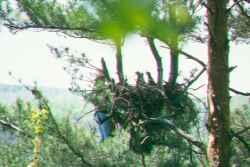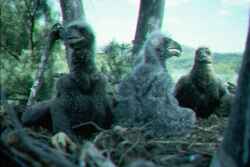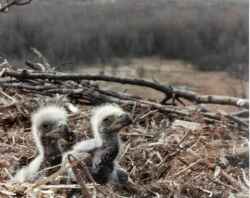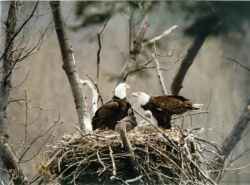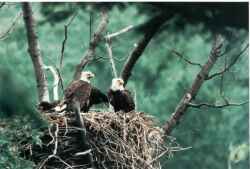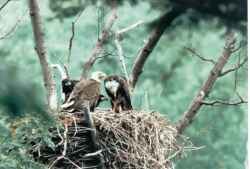 |
Great Expectations
The 1986 breeding season developed normally although somewhat later than the previous year. Incubation was initiated on April 7th and continued until the morning of May 12th, when the female suddenly abandoned the nest. The reason became apparent the following day when the shattered fragments of the single egg that was present were recovered. Now what? Since no egg contents were salvageable, a complete analysis could not be conducted. However, the egg shell revealed no reduction in thickness so contaminants did not appear to be the problem. So what had caused this unsettling turn of events? That answer will never know for sure. It is possible that the egg was simply infertile, as had been the case with the second egg in 1985. One thing that is known for certain, since the female was actively incubating when the egg broke, and from the smell of the contents that had dried on the shell fragments that were retrieved, a bath for the female would have definitely been in order. Whewww!! Wait 'till next year! Incubation during the 1987 nesting season began near the end of March, but ended just a week later when an early spring storm dropped almost ten inches of wet snow, followed by soaking rains toppling the nest and the two eggs that had been present. The site was subsequently abandoned and for the second straight year no eaglets were produced. Just when you think you have all the answers! Mr. "Murphy" had apparently been present at the site for two straight years so to say the least, 1988 was approached with some apprehension. Surprisingly, the birds were incubating by March 12th. This was an entire week earlier than had ever been observed previously, and was most likely related to the relatively mild winter of that year. The egg that was present hatched on April 17th and the eaglet fledged later that summer. The entire season concluded without incident, and a collective sigh of relief was believed to have been overheard from all parties involved, including the eagles!
Both resident eagles had been present the previous day and all appeared normal. Over the next two and a half weeks, no sign of either of those birds could be found. The intruder, on the other hand, was on or near the nest almost constantly. As it turned out, this bird was identified from that wing streamer as a member of the "class of 1985," that had been released from the hack site near Albany, NY , nearly 250 miles to the east. Finally, on April 9th, the resident male returned and was observed on the nest with the new bird. The size difference between the two was incredible. In the case of most birds of prey, females are usually larger and heavier than their mates. In the case of bald eagles, or at least the ones seen here over the years, that difference had been very subtle. That was no longer the case as the new bird was nearly one and a half times the size of the male. No wonder he had disappeared for such a long time, and now almost appeared fearful of his new nest mate. Talk about a bad blind date! Although an obvious pair bond began to develop between the two birds, it was apparent it was much too late in the season to expect successful breeding. At this point you might begin to form a conclusion that all those involved with this site were becoming more than a little paranoid about what would happen next. Actually, that would show that you have excellent deductive reasoning. Realistically however, the events of the mid to late 1980's only support the certainty that there are always unforeseen variables when dealing with nature. The 1990's proved to be a decade of much greater consistency as far as successful hatching was concerned. During the seven breeding seasons that occurred between 1990 and 1996, successful hatching took place on six occasions, with a total of eleven young being produced. After all, who in their right mind would want to mess with this female? For the most part, no unforeseeable problems were encountered until midway through the 1996 season. That year, the DEC cooperated with the Salisbury Maryland Zoo, which was attempting to find "a home" for an eaglet that had been hatched at that facility. So far that season, NY # 1 had progressed normally, and two young were known to be present in the nest. Interestingly, the eaglet produced in Salisbury had hatched on, or about the same day as the eaglets here. Although three young in a wild nest is by no means rare, it had not been seen previously at this site. However the local food supply that year was abundant, and given the fact that the adult eagles here had already delivered eight young over the previous six seasons, a supplemental fostering attempt seemed like a perfect fit. Arrangement were made with the folks at Salisbury, and on May 31st they delivered their"prize" to a small municipal airport close to the nesting territory. A short time later, this four week old, somewhat bewildered transplant, sat firmly between its new cousins.
Over the next two days both adults took turns caring for the trio of eaglets. Typically the female does the majority of the brooding while the male is out foraging. So now, with three mouths to feed instead of two, it was fortunate that the food supply was abundant. What was unknown at that time was that this abundance would ultimately make the difference between the success and failure of the site that year. When the observers left their "post" at last light on the evening of June 2nd,they had no way of knowing that they had made what would turn out to be the last confirmed sighting of the resident female. By June 4th it had become painfully clear that the female had vanished. What could possibly have happened? Conceivably, the fostering intrusion was too much for her to endure and she simply left the area. However, for her to abandon the two young she had been caring for for nearly a month, would be highly improbable. Additionally, she had been observed diligently caring for all three of the eaglets prior to her disappearance? At last view she still carried the yellow wing streamer but no subsequent reports of that distinctive marking have ever been confirmed. There are any number of factors that could have come into play in this case but so far, the question of her disappearance has gone unanswered. What now of the male and the three young that were left to depend on him? Again the dedication and diligence of the volunteer observers manifested itself as surveillance of the site increased dramatically over the next few weeks. Safeguards were put in place to so that food could be strategically situated near the site if it appeared that the male was struggling to keep up with the three growing eaglets. As a last resort preparations were made to remove the young if it became apparent that their physical condition was deteriorating. Fostering at other nests was an option if it became necessary. Now - remember back to 1978 when you all said - typical male - regarding his reluctance to return after the fostering attempt? The resident male in 1996 proved to be anything but typical. Over the seven weeks that ensued after the female's disappearance, he maintained a blistering pace of searching, securing, and delivering anything that might be considered edible to the rapidly developing brood. Although he certainly didn't have the luxury of spending much time with the trio (not to mention that space on the nest was at a premium as the weeks passed) beginning on July 23rd and progressing until the 28th, all three eaglets successfully fledged. We had definitely witnessed an inspiring turn of events. During the second week of September that same year, another eagle was observed with the male in the vicinity of the nest site. The apparent newcomer was slightly larger, which would indicate that he had found a new mate. It was hard to imagine that in just over twenty years we were witnessing yet another change in the makeup of the resident pair of eagles at the site. It is generally accepted that eagles will mate for life, but if some misfortune were to befall one member of a pair, the remaining bird will most certainly attempt to locate another mate. It just seemed to occur more frequently than anyone expected. No wonder bald eagles had been reduced to remnant populations throughout most of the lower forty-eight states! Beginning the following Spring, (1997) and continuing to the present day, these two birds have remained together and have successfully produced another seven eaglets.
|
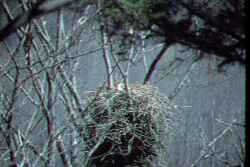 Since
natural production was once again evident, circumstances would indicate
that efforts could be directed exclusively towards the latter stages
of the hacking program and attempting to locate new territories. Or
could they?
Since
natural production was once again evident, circumstances would indicate
that efforts could be directed exclusively towards the latter stages
of the hacking program and attempting to locate new territories. Or
could they? 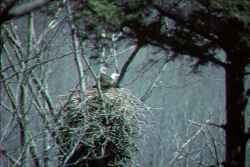 The
overconfidence radiated prior to the failures of the two previous years
had been replaced by cautious optimism after a second season of nesting
success. Incubation in 1989 was first documented on March 8th, which
was again a record early date for this site. However, (don't you just
hate that word?) on March 20th, it became evident that something had
undoubtedly gone wrong. Neither of the resident eagles was present at
the site. In their place was what appeared to be four year old "sub-adult"
of exceptional size carrying a bright yellow wing streamer, indicating
she was an eagle hacked in New York. But what was she doing here? And
why now? It was hard enough to contend with nesting failures without
having other eagles be the cause.
The
overconfidence radiated prior to the failures of the two previous years
had been replaced by cautious optimism after a second season of nesting
success. Incubation in 1989 was first documented on March 8th, which
was again a record early date for this site. However, (don't you just
hate that word?) on March 20th, it became evident that something had
undoubtedly gone wrong. Neither of the resident eagles was present at
the site. In their place was what appeared to be four year old "sub-adult"
of exceptional size carrying a bright yellow wing streamer, indicating
she was an eagle hacked in New York. But what was she doing here? And
why now? It was hard enough to contend with nesting failures without
having other eagles be the cause. 